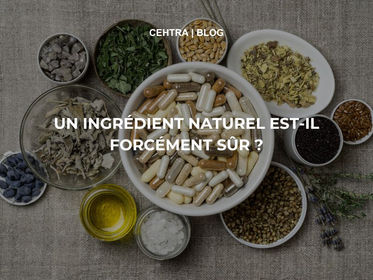top of page
Regulatory news and experts insights.
Stay updated with the latest developments, guidance, and resources in chemical regulations.
Search


The European Positive Lists (EUPL) at the Core of Directive (EU) 2020/2184
La Directive (UE) 2020/2184 établit un cadre harmonisé destiné à garantir la sécurité des matériaux et des produits entrant en contact avec l’eau destinée à la consommation humaine. Pour atteindre cet objectif, elle introduit un dispositif central : les Listes Positives Européennes (EUropean Positive Lists, EUPL).
Dec 34 min read


Directive (EU) 2020/2184: Revision of Drinking Water Quality Standards in EU
The Directive (EU) 2020/2184, adopted on December 16, 2020, marks a pivotal change in the management of drinking water across EU. It replaces the 1998 directive and aims to ensure universal access to safe and high-quality drinking water while enhancing transparency, monitoring, and risk management. This legislation has significant implications for water suppliers, industries dealing with materials in contact with water, as well as consultants and other stakeholders in the sec
Nov 196 min read


The Era of N-Nitrosamines in the Pharmaceutical Industry – A Comprehensive Toxicological Perspective
L'apparition inattendue d'impuretés de N-nitrosamines dans les médicaments a marqué un tournant réglementaire majeur. Ces composés, connus dans l'environnement et l'alimentation, ont forcé l'industrie pharmaceutique mondiale à revoir ses processus. Face à cette situation, une coordination internationale sans précédent a vu le jour entre les agences réglementaires mondiales, telles que la FDA (États-Unis),
Nov 54 min read


How to Determine if Your Ingredient Is a Novel Food ?
When a company develops a new ingredient, whether it is a concentrated plant extract, a biotech-derived ferment, a processed algae or a “functional” mushroom, one recurring question always arises: is a Novel Food procedure required before marketing the ingredient within the EU?
This question often emerges when the project is already well advanced: the formulation is nearly finalized, the marketing identity is ready, the first commercial discussions have started…
Oct 294 min read


ToxCast Database Update: A Key Asset for Endocrine Disruptor Assessment and CEHTRA’s Digital Tool
The identification of endocrine disruptors (EDs) has become a major public health and environmental concern worldwide. EDs are chemical substances capable of interfering with the hormonal system, leading to adverse effects on both humans and wildlife. Monitoring and assessing these substances is essential to protect human health, particularly among vulnerable populations such as pregnant women, children, and wild species.
To this end, the U.S. Environmental Protection Agen
Oct 223 min read


PFAS in Plant Protection Products: Latest Regulatory Developments and Perspectives
Les substances per- et polyfluoroalkylées (PFAS) font l’objet d’une attention croissante des autorités européennes en raison de leur persistance, bioaccumulation et toxicité.Dans ce contexte, le secteur des produits phytopharmaceutiques (PPP) est désormais scruté de près à travers le rapport de restriction de l’Annexe XV de l’ECHA.
Ce rapport indique que les substances actives utilisées dans les PPP, les produits biocides et les produits médicinaux se distinguent chimiquemen
Oct 132 min read


CEHTRA, Regulatory expertise driven by human and responsible values
At CEHTRA, regulatory expertise goes beyond compliance. Our strength lies in a human-driven, client-focused approach supported by collective intelligence and responsible scientific commitment.
Oct 72 min read


CEHTRAWATCH: the smart digital regulatory monitoring tool for effortless compliance
Discover Cehtrawatch, the digital regulatory monitoring tool that keeps your business compliant with controlled updates and no software installation needed.
Sep 302 min read


What Is an Endocrine Disruptor? Definition, Identification and EU Regulatory Criteria
Learn what an endocrine disruptor is, how EDs are identified in the EU, and the regulatory criteria used under CLP, biocides, and pesticides. Discover how CEHTRA supports ED assessment and classification.
Sep 232 min read


n-Hexane: An Omnipresent Solvent, Soon to Be Classified as a “Substance of Very High Concern”?
n-Hexane (CAS No. 110-54-3) is a volatile aliphatic hydrocarbon derived from petroleum distillation. Used as a solvent, it plays a key role in several sectors:
Food industry: extraction of vegetable oils (soy, rapeseed, sunflower), flavors, and proteins.
Cosmetics and perfumery: obtaining absolutes, essential oils, and pure plant extracts.
Its popularity is based on its efficiency, high yield, and low cost. However, this solvent requires strict purification to limit res
Sep 162 min read


Natural ingredients and food safety: myths, realities, and best practices
Lorsqu’on parle de nutrition, de compléments alimentaires ou d’ingrédients innovants, le mot “naturel” inspire immédiatement confiance. Mais est-ce qu’un ingrédient naturel est toujours sûr pour la consommation ?
Spoiler alert : pas nécessairement. Et c’est justement ce que les scientifiques et les experts en sécurité alimentaire s’attachent à démontrer, preuve à l’appui.
Sep 102 min read


Glabridine: An Ingredient Under Scrutiny in Cosmetics
Glabridine is an isoflavonoid (isoflavane) extracted from Glycyrrhiza glabra (licorice root). It is widely used in cosmetics for its skin-lightening and anti-tyrosinase activity, as well as for its antioxidant and anti-inflammatory properties. It is mainly found in skincare products, anti-aging creams, and sunscreens.
Sep 21 min read


ECHA Issues New Restrictions on HOMONOPAL (Pinoacetaldehyde) – CAS 33885-51-7
HOMONOPAL, également connu sous le nom de Pinoacétaldéhyde, est un aldéhyde aromatique synthétique couramment utilisé dans les compositions parfumées. Son numéro CAS est 33885-51-7. Reconnu pour son odeur verte, florale et légèrement aldéhydée, ce composé apporte de la fraîcheur et de la vivacité aux accords parfumés, en particulier dans les parfums de luxe, les produits de soin personnel et les formulations de nettoyage.
Aug 272 min read


Framework Guidance: Analysis of alternatives tobiocidal active substances
ECHA developed in 2022 a recommended (i.e. not mandatory) framework guidance to applicants for approval of biocidal active substances but also to Member State Competent Authorities (MSCAs) on how to perform an analysis of alternatives (AoA) to active substances being candidate for substitution (CfS) according to Art. 10(1) of the Biocidal Products Regulation ((EU) 528/2012). The guidance has been adopted at BPC-45 meeting and published in January 2023.
Mar 1, 20233 min read


ADBAC/BKC in PT2 - Information on Approval Status
On 2nd of December 2021, the ECHA Biocidal Products Committee (BPC) recommended the approval of ABDAC/BKC and adopted the BPC opinion for PT2 by simple majority. Two Member States (Germany and Finland) raised their concerns about unacceptable risk for environment, mainly for the soil compartment.
Feb 1, 20232 min read


Disinfectants and Biocides: Application Frequency Must Be Specified – New Rules from CG-54
In the recent meeting of Coordination Group (CG-54), a proposal of the Austrian Member State was discussed which has been raised in a CG e-consultation, concerning information on the use frequency of products (“Number and timing of application”) for use in PT 1, PT2 and PT4 given by the applicants in SPC and PAR for BPR product authorization.
Dec 1, 20222 min read
bottom of page
